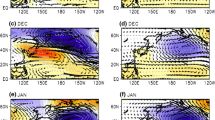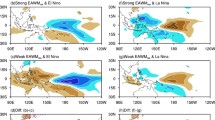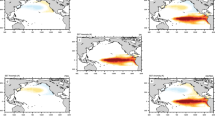Abstract
Precipitation in California is modulated by variability in the tropical Pacific associated with El Niño/Southern Oscillation (ENSO): more rainfall is expected during El Niño episodes, and reduced rainfall during La Niña. It has been suggested that besides the shape and location of the sea surface temperature (SST) anomaly this remote connection depends on the strength and location of the atmospheric convection response in the tropical Pacific. Here we show in a perturbed physics ensemble of the Kiel Climate Model and CMIP5 models that due to a cold equatorial SST bias many climate models are in a La Niña-like mean state, resulting in a too westward position of the rising branch of the Pacific Walker Circulation. This in turn results in a convective response along the equator during ENSO events that is too far west in comparison to observations. This effect of the equatorial cold SST bias is not restricted to the tropics, moreover it leads to a too westward SLP response in the North Pacific and too westward precipitation response that does not reach California. Further we show that climate models with a reduced equatorial cold SST bias have a more realistic representation of the spatial asymmetry of the teleconnections between El Niño and La Niña.














Similar content being viewed by others
References
Ashok K, Behera SK, Rao SA, Weng H, Yamagata T (2007) El Niño Modoki and its possible teleconnection. J Geophys Res 112. https://doi.org/10.1029/2006JC003798
Ayarzagüena B, Ineson S, Dunstone NJ, Baldwin MP, Scaife AA (2018) Intraseasonal effects of El Niño-Southern Oscillation on North Atlantic climate. J Clim 31:8861–8873. https://doi.org/10.1175/JCLI-D-18-0097.1
Banzon V, Smith TM, Chin TM, Liu C, Hankins W (2016) A long-term record of blended satellite and in situ sea-surface temperature for climate monitoring, modeling and environmental studies. Earth Syst Sci Data 8(1):165–176. https://doi.org/10.5194/essd-8-165-2016
Barnston AG, Livezey RE (1987) Classification, seasonality and persistence of low-frequency atmospheric circulation patterns. Mon Weather Rev 115:1083–1126
Bayr T, Dommenget D (2013) The tropospheric land–sea warming contrast as the driver of tropical sea level pressure changes. J Clim 26(4):1387–1402. https://doi.org/10.1175/JCLI-D-11-00731.1
Bayr T, Dommenget D, Martin T, Power SB (2014) The eastward shift of the Walker Circulation in response to global warming and its relationship to ENSO variability. Clim Dyn 43(9):2747–2763. https://doi.org/10.1007/s00382-014-2091-y
Bayr T, Latif M, Dommenget D, Wengel C, Harlaß J, Park W (2018a) Mean-state dependence of ENSO atmospheric feedbacks in climate models. Clim Dyn 50(9–10):3171–3194. https://doi.org/10.1007/s00382-017-3799-2
Bayr T, Wengel C, Latif M, Dommenget D, Lübbecke J, Park W (2018b) Error compensation of ENSO atmospheric feedbacks in climate models and its influence on simulated ENSO dynamics. Clim Dyn. https://doi.org/10.1007/s00382-018-4575-7
Bellenger H, Guilyardi E, Leloup J, Lengaigne M, Vialard J (2014) ENSO representation in climate models: from CMIP3 to CMIP5. Clim Dyn 42(7–8):1999–2018. https://doi.org/10.1007/s00382-013-1783-z
Brönnimann S (2007) Impact of El Niño-Southern Oscillation on European climate. Rev Geophys 45(3):1–28
Butler AH, Polvani LM (2011) El Niño, La Niña, and stratospheric sudden warmings: a reevaluation in light of the observational record. Geophys Res Lett 38(13):L13–807. https://doi.org/10.1029/2011GL048084
Butler AH, Arribas A, Athanassiadou M, Baehr J, Calvo N, Charlton-Perez A, Déqué M, Domeisen DIV, Fröhlich K, Hendon H, Imada Y, Ishii M, Iza M, Karpechko AY, Kumar A, MacLachlan C, Merryfield WJ, Müller WA, O’Neill A, Scaife AA, Scinocca J, Sigmond M, Stockdale TN, Yasuda T (2016) The Climate-system Historical Forecast Project: do stratosphere-resolving models make better seasonal climate predictions in boreal winter? Q J R Meteorol Soc 142(696):1413–1427
Capotondi A, Wittenberg AT, Newman M, Di Lorenzo E, Yu JY, Braconnot P, Cole J, Dewitte B, Giese B, Guilyardi E, Jin FF, Karnauskas K, Kirtman B, Lee T, Schneider N, Xue Y, Yeh SW (2015) Understanding ENSO diversity. Bull Am Meteorol Soc 96(6):921–938
Cayan DR, Redmond KT, Riddle LG (1999) ENSO and hydrologic extremes in the Western United States: EBSCOhost. J Clim 12:2881–2893
Chen Z, Gan B, Wu L, Jia F (2018) Pacific-North American teleconnection and North Pacific Oscillation: historical simulation and future projection in CMIP5 models. Clim Dyn 50(11–12):4379–4403. https://doi.org/10.1007/s00382-017-3881-9
Chiew FHS, Piechota TC, Dracup JA, McMahon TA (1998) El Nino/Southern Oscillation and Australian rainfall, streamflow and drought: links and potential for forecasting. J Hydrol 204(1–4):138–149
Chiodi AM, Harrison DE (2013) El Niño impacts on seasonal US atmospheric circulation, temperature, and precipitation anomalies: the OLR-event perspective*. J Clim 26(3):822–837
Chiodi AM, Harrison DE (2015) Global seasonal precipitation anomalies robustly associated with El Niño and La Niña events—an OLR perspective*. J Clim 28(15):6133–6159
Davey M, Huddleston M, Sperber K, Braconnot P, Bryan F, Chen D, Colman R, Cooper C, Cubasch U, Delecluse P, DeWitt D, Fairhead L, Flato G, Gordon C, Hogan T, Ji M, Kimoto M, Kitoh A, Knutson T, Latif M, Le Treut H, Li T, Manabe S, Mechoso C, Meehl G, Power S, Roeckner E, Terray L, Vintzileos A, Voss R, Wang B, Washington W, Yoshikawa I, Yu J, Yukimoto S, Zebiak S (2002) STOIC: a study of coupled model climatology and variability in tropical ocean regions. Clim Dyn 18(5):403–420. https://doi.org/10.1007/s00382-001-0188-6
Dee D, Uppala S, Simmons A, Berrisford P, Poli P, Kobayashi S, Andrae U, Balmaseda M, Balsamo G, Bauer P, Bechtold P, Beljaars A, Berg L, Bidlot J, Bormann N, Delsol C, Dragani R, Fuentes M, Geer A, Haimberger L, Healy S, Hersbach H, Holm E, Isaksen L, Kållberg P, Köhler M, Matricardi M, McNally A, Monge-Sanz B, Morcrette J, Park B, Peubey C, Rosnay Pd, Tavolato C, Thepaut J, Vitart F (2011) The ERA-Interim reanalysis: configuration and performance of the data assimilation system. Q J Royal Met Soc 137:553–597
Deser C, Simpson IR, McKinnon KA, Phillips AS, Deser C, Simpson IR, McKinnon KA, Phillips AS (2017) The Northern Hemisphere extra-tropical atmospheric circulation response to ENSO: How well do we know it and how do we evaluate models accordingly? J Clim. https://doi.org/10.1175/JCLI-D-16-0844.1
Deser C, Simpson IR, Phillips AS, McKinnon KA (2018) How well do we know ENSO’s climate impacts over North America, and how do we evaluate models accordingly? J Clim 31(13):4991–5014. https://doi.org/10.1175/JCLI-D-17-0783.1
Ding S, Chen W, Graf HF, Guo Y, Nath D (2017) Distinct winter patterns of tropical Pacific convection anomaly and the associated extratropical wave trains in the Northern Hemisphere. Clim Dyn 4(C11):1147
Domeisen DIV, Butler AH, Fröhlich K, Bittner M, Müller WA, Baehr J (2015) Seasonal predictability over Europe arising from El Niño and stratospheric variability in the MPI-ESM seasonal prediction system. J Clim 28(1):256–271
Domeisen DIV, Garfinkel CI, Butler AH (2019) The teleconnection of El Niño Southern Oscillation to the stratosphere. Rev Geophys. https://doi.org/10.1029/2018RG000596
Dommenget D, Haase S, Bayr T, Frauen C (2014) Analysis of the Slab Ocean El Nino atmospheric feedbacks in observed and simulated ENSO dynamics. Clim Dyn 42(11–12):3187–3205
Dong L, Leung LR, Song F, Lu J (2018) Roles of SST versus internal atmospheric variability in winter extreme precipitation variability along the US West Coast. J Clim 31(19):8039–8058. https://doi.org/10.1175/JCLI-D-18-0062.1
Drews A, Greatbatch RJ, Ding H, Latif M, Park W (2015) The use of a flow field correction technique for alleviating the North Atlantic cold bias with application to the Kiel Climate Model. Ocean Dyn 65(8):1079–1093. https://doi.org/10.1007/s10236-015-0853-7
Dunstone N, Smith D, Scaife A, Hermanson L, Eade R, Robinson N, Andrews M, Knight J (2016) Skilful predictions of the winter North Atlantic Oscillation 1 year ahead. Nat Geosci 9(11):809–814
Frauen C, Dommenget D, Tyrrell N, Rezny M, Wales S (2014) Analysis of the nonlinearity of El Niño-Southern Oscillation teleconnections*. J Clim 27(16):6225–6244
Garfinkel CI, Butler AH, Waugh DW, Hurwitz MM, Polvani LM (2012a) Why might stratospheric sudden warmings occur with similar frequency in El Niño and La Niña winters? J Geophys Res Atmos 117. https://doi.org/10.1029/2012JD017777
Garfinkel CI, Hurwitz MM, Waugh DW, Butler AH (2012b) Are the teleconnections of Central Pacific and Eastern Pacific El Niño distinct in boreal wintertime? Clim Dyn 41(7–8):1835–1852
Garfinkel CI, Weinberger I, White IP, Oman LD, Aquila V, Lim YK (2018) The salience of nonlinearities in the boreal winter response to ENSO: North Pacific and North America. Clim Dyn 4(C11):1147
Giese BS, Ray S (2011) El Niño variability in simple ocean data assimilation (SODA), 1871–2008. J Geophys Res 116:C02024. https://doi.org/10.1029/2010JC006695
Gill AE (1980) Some simple solutions for heat-induced tropical circulation. Q J R Meteorol Soc 106(449):447–462. https://doi.org/10.1002/qj.49710644905
Guan C, McPhaden MJ (2016) Ocean processes affecting the twenty-first-century shift in ENSO SST variability. J Clim 29(19):6861–6879
Guilyardi E, Wittenberg A, Fedorov A, Collins M, Wang C, Capotondi A, van Oldenborgh GJ, Stockdale T (2009) Understanding El Niño in ocean–atmosphere general circulation models: progress and challenges. Bull Am Meteorol Soc 90(3):325–340. https://doi.org/10.1175/2008BAMS2387.1
Harlaß J, Latif M, Park W (2015) Improving climate model simulation of tropical Atlantic sea surface temperature: the importance of enhanced vertical atmosphere model resolution. Geophys Res Lett 42(7):2401–2408. https://doi.org/10.1002/2015GL063310
Hoell A, Hoerling M, Eischeid J, Wolter K, Dole R, Perlwitz J, Xu T, Cheng L (2016) Does El Niño intensity matter for California precipitation? Geophys Res Lett 43(2):819–825
Hoskins BJ, Karoly D (1981) The steady linear response of a spherical atmosphere to thermal and orographic forcing. J Atmos Sci 38(06):1179–1196
Hurwitz MM, Song IS, Oman LD, Newman PA, Molod AM, Frith SM, Nielsen JE (2011) Response of the Antarctic stratosphere to warm pool El Niño Events in the GEOS CCM. Atmos Chem Phys 11(18):9659–9669
Jiménez-Esteve B, Domeisen DI (2019) Nonlinearity in the North Pacific atmospheric response to a linear ENSO forcing. Geophys Res Lett. https://doi.org/10.1029/2018gl081226
Jiménez-Esteve B, Domeisen DIV (2018) The Tropospheric Pathway of the ENSO-North Atlantic Teleconnection. J Clim. https://doi.org/10.1175/JCLI-D-17-0716.1
Johnson NC, Kosaka Y (2016) The impact of eastern equatorial Pacific convection on the diversity of boreal winter El Niño teleconnection patterns. Clim Dyn 47(12):3737–3765. https://doi.org/10.1007/s00382-016-3039-1
Jong BT, Ting M, Seager R (2016) El Niño’s impact on California precipitation: seasonality, regionality, and El Niño intensity. Environ Res Lett 11(5):054021
Kao HY, Yu JY (2009) Contrasting Eastern-Pacific and Central-Pacific types of ENSO. J Clim 22(3):615–632. https://doi.org/10.1175/2008JCLI2309.1
Kim WM, Cai W (2014) The importance of the eastward zonal current for generating extreme El Niño. Clim Dyn 42(11–12):3005–3014. https://doi.org/10.1007/s00382-013-1792-y
Kug J-S, Ham Y-G (2011) Are there two types of La Nina? Geophys Res Lett 38:L16704. https://doi.org/10.1029/2011GL048237
Kumar A, Chen M (2017) What is the variability in US west coast winter precipitation during strong El Niño events? Clim Dyn 49(7–8):2789–2802. https://doi.org/10.1007/s00382-016-3485-9
Larkin NK, Harrison DE (2005) Global seasonal temperature and precipitation anomalies during El Niño autumn and winter. Geophys Res Lett 32. https://doi.org/10.1029/2005GL022860
Latif M, Keenlyside NS (2009) El Niño/Southern Oscillation response to global warming. PNAS 106(49):20578–20583
Leathers DJ, Palecki MA (1992) The Pacific/North American teleconnection pattern and United States climate. Part II: Temporal characteristics and index specification. J Clim 5(7):707–716
Leathers DJ, Yarnal B, Palecki MA (1991) The Pacific/North American teleconnection pattern and United States climate. Part I: Regional temperature and precipitation associations. J Clim 4(5):517–528
Lee SK, Lopez H, Chung ES, DiNezio P, Yeh SW, Wittenberg AT (2018) On the Fragile relationship between El Niño and California rainfall. Geophys Res Lett 45(2):907–915. https://doi.org/10.1002/2017GL076197
Liebmann B, Smith CA (1996) Description of a complete (interpolated) outgoing longwave radiation dataset. Bull Am Meteorol Society 77(6):1275–1277
Lloyd J, Guilyardi E, Weller H (2012) The role of atmosphere feedbacks during ENSO in the CMIP3 models. Part III: The shortwave flux feedback. J Clim 25(12):4275–4293. https://doi.org/10.1175/JCLI-D-11-00178.1
Lu J, Chen G, Frierson DMW (2008) Response of the zonal mean atmospheric circulation to El Niño versus global warming. J Clim 21:5835–5851. https://doi.org/10.1175/2008JCLI2200.1
MacDonald GM, Kremenetski KV, Hidalgo HG (2008) Southern California and the perfect drought: simultaneous prolonged drought in southern California and the Sacramento and Colorado River systems. Q Int 188(1):11–23
Madec G (2008) NEMO ocean engine. Note du Pole de modélisation 27, Institut Pierre-Simon Laplace p 193
Mauritsen T, Stevens B, Roeckner E, Crueger T, Esch M, Giorgetta M, Haak H, Jungclaus J, Klocke D, Matei D, Mikolajewicz U, Notz D, Pincus R, Schmidt H, Tomassini L (2012) Tuning the climate of a global model. J Adv Model Earth Syst 4(3) https://doi.org/10.1029/2012MS000154
McPhaden MJ (2012) A 21st century shift in the relationship between ENSO SST and warm water volume anomalies. Geophys Res Lett 39(9)
Mo KC, Higgins RW (1998) Tropical influences on California precipitation. J Clim 11(3):412–430
Mo KC, Livezey RE (1986) Tropical-extratropical geopotential height teleconnections during the Northern Hemisphere Winter. Mon Weather Rev 114(12):2488–2515
Paek H, Yu JY, Qian C (2017) Why were the 2015/2016 and 1997/1998 extreme El Niños different? Geophys Res Lett 44(4):1848–1856. https://doi.org/10.1002/2016GL071515
Park W, Keenlyside N, Latif M, Ströh A, Redler R, Roeckner E, Madec G (2009) Tropical Pacific climate and its response to global warming in the Kiel Climate model. J Clim 22(1):71–92
Piechota TC, Dracup JA (1996) Drought and regional hydrologic variations in the United States: associations with the El Niño-Southern Oscillation. Water Resour Res 32(5):1359–1373
Piechota TC, Dracup JA, Fovell RG (1997) Western US streamflow and atmospheric circulation patterns during El Niño-Southern Oscillation. J Hydrol 201(1–4):249–271
Rasmusson EM, Wallace JM (1983) Meteorological aspects of the El Niño/Southern Oscillation. Science 222:1195–1202
Roeckner E, Baeuml G, Bonventura L, Brokopf R, Esch M, Giorgetta M, Hagemann S, Kirchner I, Kornblueh L, Manzini E, Rhodin A, Schlese U, Schulzweida U, Tompkins A (2003) The atmospheric general circulation model ECHAM5. Part I: Model description. 349, Max Planck Institute for Meteorology, Hamburg, Germany
Schonher T, Nicholson SE (1989) The relationship between California Rainfall and Enso Events. J Clim 2(11):1258–1269
Seager R, Naik N, Ting M, Cane MA, Harnik N, Kushnir Y (2010) Adjustment of the atmospheric circulation to tropical Pacific SST anomalies: variability of transient eddy propagation in the Pacific-North America sector. Q J R Meteorol Society 136:277–296
Siler N, Kosaka Y, Xie SP, Li X (2017) Tropical ocean contributions to California’s surprisingly dry El Niño of 2015/16. J Clim 30(24):10,067–10,079. https://doi.org/10.1175/JCLI-D-17-0177.1
Sun Y, Wang F, Sun DZ (2016) Weak ENSO asymmetry due to weak nonlinear air–sea interaction in CMIP5 climate models. Adv Atmos Sci 33(3):352–364. https://doi.org/10.1007/s00376-015-5018-6
Takaya K, Nakamura H (2001) A formulation of a phase-independent wave-activity flux for stationary and migratory quasigeostrophic eddies on a zonally varying basic flow. J Atmos Sci 58:608–627. https://doi.org/10.1109/27.659538
Taylor KE, Stouffer RJ, Ga Meehl (2012) An overview of CMIP5 and the experiment design. Bull Am Meteorol Soc 93(4):485–498. https://doi.org/10.1175/BAMS-D-11-00094.1
Timmermann A, Si An, Js Kug, Ff Jin, Cai W, Cobb K, Lengaigne M, Mcphaden MJ, Malte F, Stein K, Wittenberg AT, Ks Yun, Bayr T, Hc Chen, Chikamoto Y, Dewitte B, Dommenget D, Grothe P, Yg Ham, Hayashi M, Ineson S, Kang D, Kim W, Jy Lee, Li T, Jj Luo, Mcgregor S, Power S, Rashid H, Hl Ren, Santoso A, Takahashi K, Todd A, Wang G, Wang G, Xie R, Yang Wh, Yeh W, Yoon J, Zeller E, Zhang X (2018) El Niño-Southern Oscillation Complexity. Nature. https://doi.org/10.1038/s41586-018-0252-6
Tompkins AM (1997) On the relationship between tropical convection and sea surface temperature. J Clim 14:633–637
Trenberth KE (1997) The definition of El Niño. Bull Am Meteorol Society 78(12):2771–2777
Trenberth KE, Stepaniak DP (2001) Indices of El Nino evolution. J Clim 14(8):1697–1701
Trenberth KE, Branstator GW, Karoly D, Kumar A, Lau NC, Ropelewski C (1998) Progress during TOGA in understanding and modeling global teleconnections associated with tropical sea surface temperatures. J Geophys Res 198103(C7):14291–14324
Vannière B, Guilyardi E, Madec G, Doblas-Reyes FJ, Woolnough S (2013) Using seasonal hindcasts to understand the origin of the equatorial cold tongue bias in CGCMs and its impact on ENSO. Clim Dyn 40(3–4):963–981. https://doi.org/10.1007/s00382-012-1429-6
Wallace JM, Gutzler DS (1981) Teleconnections in the geopotential height field during the northern hemisphere winter. Mon Weather Rev 109(4):784–812
Wang S, Anichowski A, Tippett MK, Sobel AH (2017) Seasonal noise versus subseasonal signal: forecasts of California precipitation during the unusual winters of 2015–2016 and 2016–2017. Geophys Res Lett 44(18):9513–9520. https://doi.org/10.1002/2017GL075052
Wang Z, Kuhlbrodt T, Meredith MP (2011) On the response of the Antarctic Circumpolar Current transport to climate change in coupled climate models. J Geophys Res 116(C8):C08–011. https://doi.org/10.1029/2010JC006757
Wengel C, Latif M, Park W, Harlaß J, Bayr T (2018) Seasonal ENSO phase locking in the Kiel Climate Model: the importance of the equatorial cold sea surface temperature bias. Clim Dyn 50(3–4):901–919. https://doi.org/10.1007/s00382-017-3648-3
Xie P, Arkin PA (1997) Global precipitation: a 17-year monthly analysis based on Gauge observations, satellite estimates, and numerical model outputs. Bull Am Meteorol Soc 78(11):2539–2558
Yoon Jin-Ho, Leung L Ruby (2015) Assessing the relative influence of surface soil moisture and ENSO SST on precipitation predictability over the contiguous United States. Geophys Res Lett 42:5005–5013. https://doi.org/10.1002/2015GL064139
Zhang T, Perlwitz J, Hoerling MP (2014) What is responsible for the strong observed asymmetry in teleconnections between El Niño and La Niña? Geophys Res Lett 41(3):1019–1025
Zhang T, Hoerling MP, Wolter K, Eischeid J, Cheng L, Hoell A, Perlwitz J, Quan XW, Barsugli J (2018a) Predictability and prediction of Southern California rains during Strong El Nino Events: a focus on the failed 2016 winter rains. J Clim 31(2):555–574
Zhang W, Wang Z, Stuecker MF, Turner AG, Jin FF, Geng X (2018b) Impact of ENSO longitudinal position on teleconnections to the NAO. Clim Dyn 15:2205–18
Acknowledgements
The authors would like to thank the anonymous reviewers for their comments that helped to improve the manuscript. We acknowledge the World Climate Research Program’s Working Group on Coupled Modeling, the individual modeling groups of the Climate Model Intercomparison Project (CMIP5), NOAA and ECMWF for providing the data sets. The climate model integrations of the KCM and ECHAM5 were performed at the Computing Centre of Kiel University and the Northern German Supercomputing Alliance (HLRN). This work is supported by the SFB grant 754 “Climate-Biochemistry Interactions in the tropical Ocean”, the Swiss National Science Foundation through Grant no. PP00P2_170523, and the German Ministry of Education and Research (BMBF) through Grant SACUS (03G0837A). The authors would like to thank Mojib Latif, Dietmar Dommenget and Gereon Gollan for helpful discussions.
Author information
Authors and Affiliations
Corresponding author
Additional information
Publisher's Note
Springer Nature remains neutral with regard to jurisdictional claims in published maps and institutional affiliations.
Rights and permissions
About this article
Cite this article
Bayr, T., Domeisen, D.I.V. & Wengel, C. The effect of the equatorial Pacific cold SST bias on simulated ENSO teleconnections to the North Pacific and California. Clim Dyn 53, 3771–3789 (2019). https://doi.org/10.1007/s00382-019-04746-9
Received:
Accepted:
Published:
Issue Date:
DOI: https://doi.org/10.1007/s00382-019-04746-9




